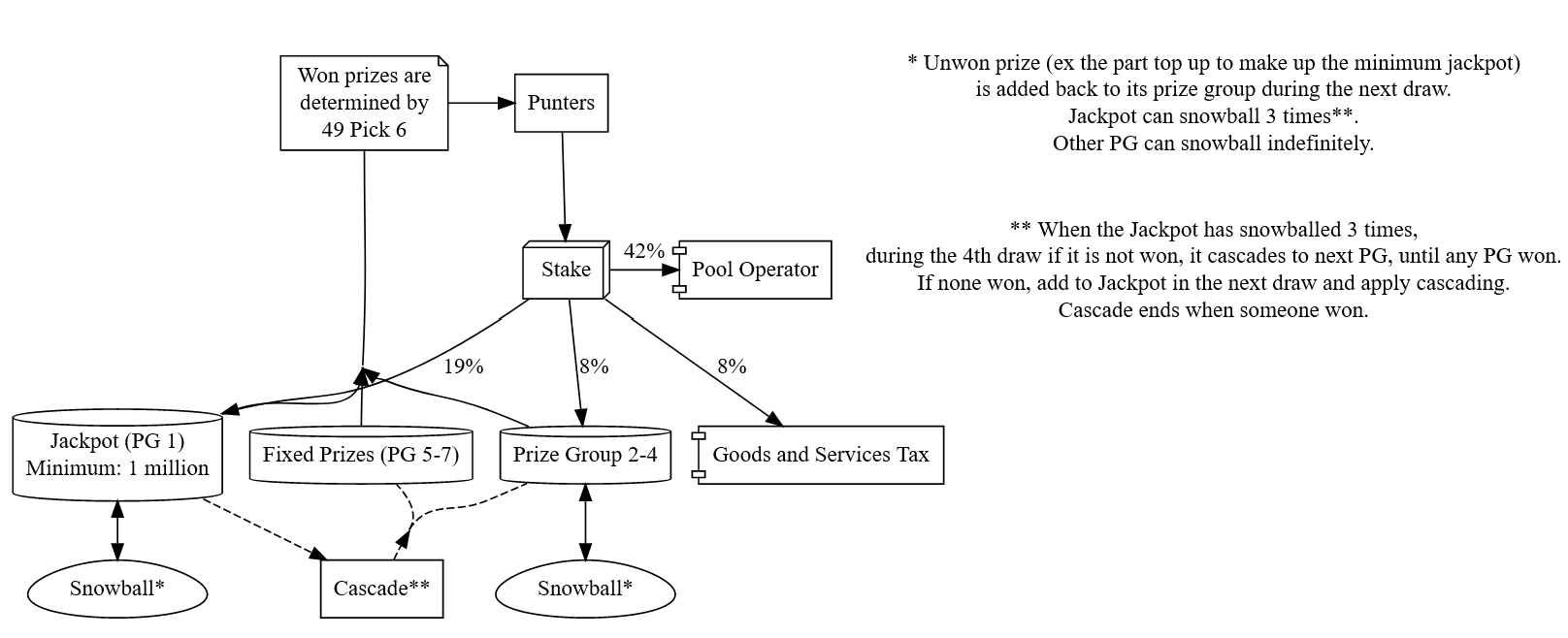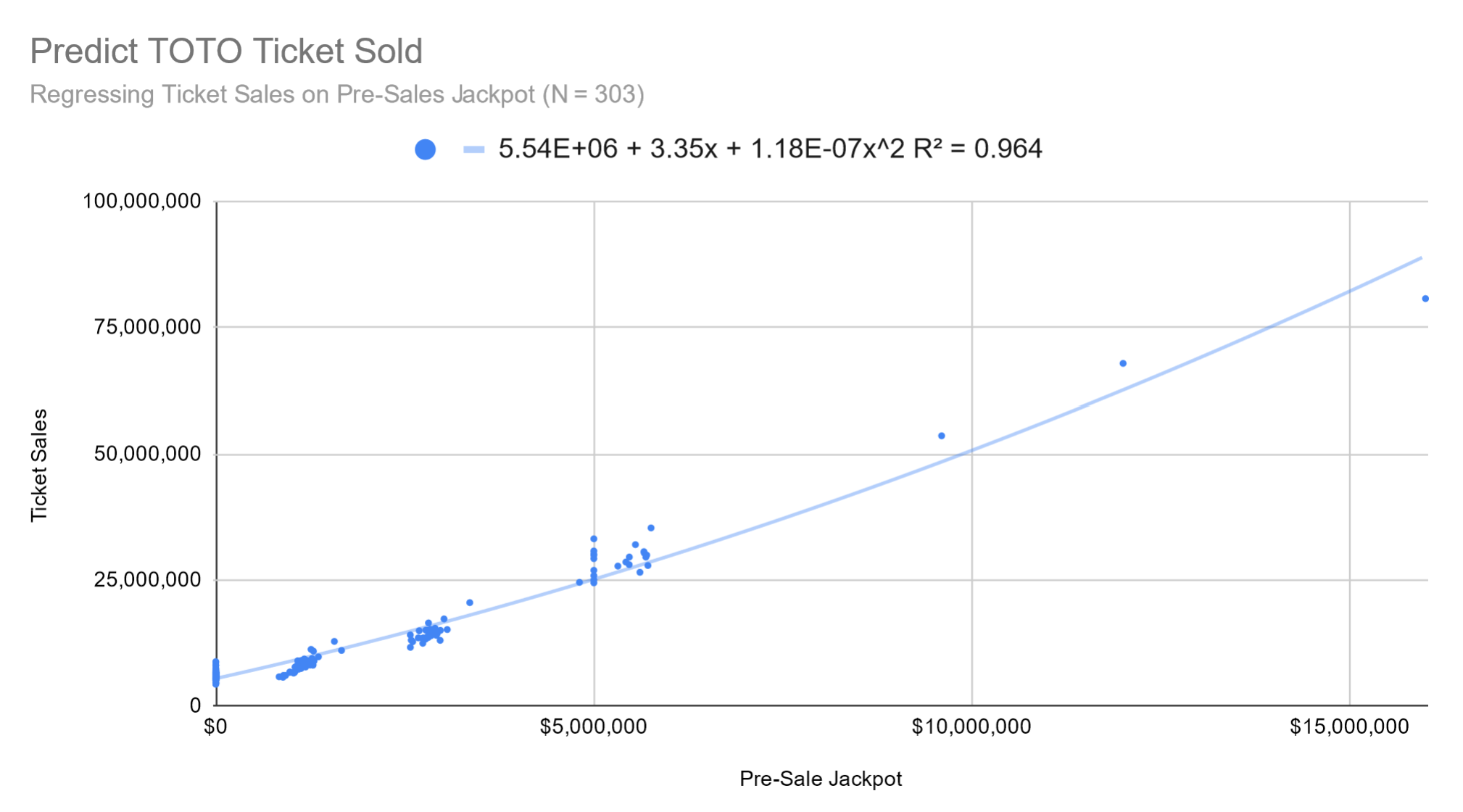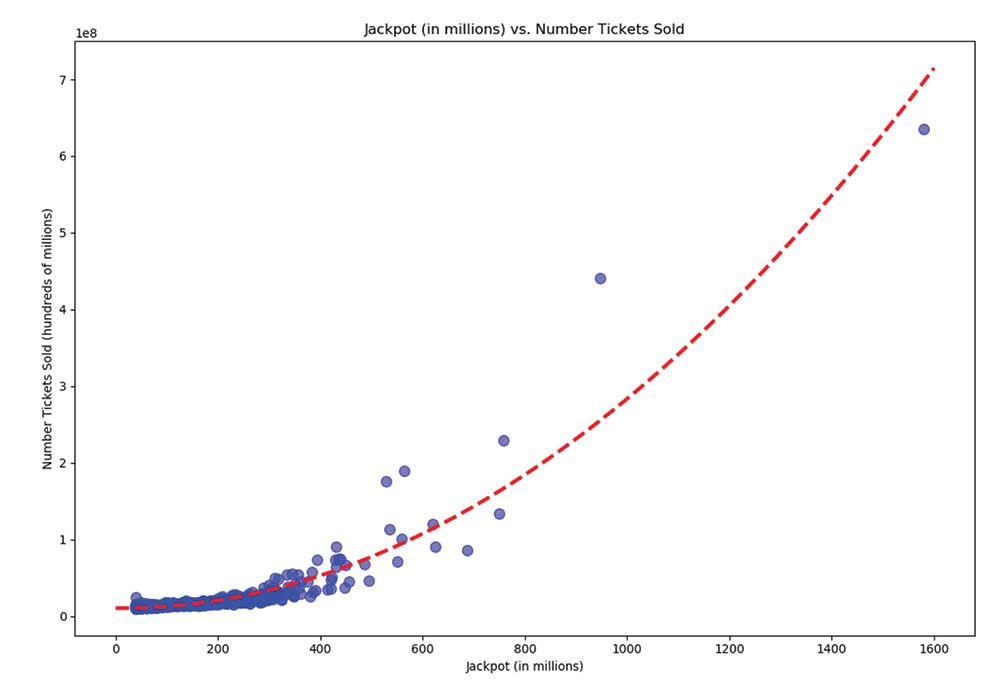Further Reflection on Singapore Pools
Previously, your faithful correspondent investigated two lottery games, 4D and Sweep, offered by Singapore Pools. The remaining one, TOTO, is more complex and thus deserves separate treatment. This article is that treatment. It aims to answer the question:
Can TOTO be beaten? Is there a way to improve expected values of winning?
All information that follows is up-to-date as of 2023-05-30. The information is not intended to be and does not constitute financial advice, investment advice, trading advice or any other advice. It is presented for entertainment only. While I tried my best to present correct information, I might still be wrong. Please act wisely.
The Game and its Players
The rule of TOTO can be found here1, 2. Below is my attempt at capturing it using a system diagram:

Figure 1: An Overview of TOTO
The complexity of TOTO originates from its system design. It is not a stationary system that behaves the same during every draw. Instead, its properties are determined by the following:
- How large is the jackpot
- The number of people who are going to play, which is influenced by the size of the jackpot and also influences the jackpot size
- Is the game in “snowball mode”, which depends on last few games
Over the course of several draws, these elements affect each other and create a stochastic system with reflexivity. This means that we cannot simply draw a table to calculate the EV of TOTO. Each draw will have to have its own table.
A further complication arises when some information is not publicly available. For example, it is not possible to know how many punters will bet before a draw is closed. Hence it is not possible to know the exact jackpot for a draw before it is closed.
At this point, you may ask, “why should I care? Isn’t it as simple as buying when the prize is big?”
The issue is that when the prize is large, there are more punters. This is not desirable because more punters mean that the prizes will be split, with each of them getting less. All else equal, a less crowded bet is a more desirable bet.
In fact, based on the past three hundred draws, it can be observed that number of ticket sold is approximately a quadratic function of the jackpot, as shown below. Interestingly, a study of Powerball in the US also show similar quadratic relationship (see Figure 3.) 3, 4.

Figure 2: TOTO Ticket Sold as a Quadratic Function of Jackpot

Figure 3: Powerball Ticket Sold as a Quadratic Function of Jackpot
While such a convex relationship is bad news for punters, it does show that number of ticket sold, and consequently, the final jackpot, is largely predictable from publicly available information. This is encouraging because it means that one can largely examine the states of the system before placing a bet.
The Snowball and the Cascade
In its essence, snowball is the part of game rule that enable the jackpot to accumulate beyond the current draw. Any unwon prizes in first four prize groups accumulate to next draw. This is what create a headline-worthy jackpot and snaking queues of punters.
Cascade happens when snowball ends. If the jackpot has been snowballed three times, and still not won in the fourth time, it cascades down to the prize group below, until won. Here the slate is wiped, jackpot is cleared and the game becomes boring again.
Astute readers can see that snowball and cascade stages are probably where money are made, if such an opportunity exists at all. The reasoning for this is straightforward. In a draw where the jackpot is purely consisting of current sales proceeding, all the punters in aggregate are only expected to get what is left of their initial stake plus some5, after the state has taken its 8% tax6 and Singapore Pools its 46% cut. However, in the case of a snowball, or better, a thrice-snowballed draw on the verge of cascading, current punters, in aggregate, have a chance or is certain to get the above, plus money left in the pool by earlier punters. In fact, this is the insight that enabled the advantage players to beat the Massachusetts Cash Winfall lottery. They only bet when the prize pool is on the verge of cascading. Just like one of those coin pushers in an arcade, it make no sense to throw in a coin when the machine is empty, whereas the same action becomes appealing when it is filled to the brim.
Balance on the Edge
So it all comes down to two opposing forces:
- The tendency of large number of punters when the jackpot is big
- The tendency of large payout when the jackpot is big
The answer to the question whether the game is beatable, or whether it has positive EV given certain strategy, is hinged on whether the system is well-designed to balance these two forces. It does not have to be. Cash Winfall wasn’t and the latter constantly outweighs the former 7, giving punters an edge.
How can we model this advantage? One option is simulation. We can simulate the lottery draw many times and observe its behaviors. Another, more elegant, idea presented in Jordan Ellenberg’s book is to consider the all punters in a draw as one entity. Namely, without caring who exactly won how much, we can consider how much money the punters as a whole put in, and how much they managed to win in total. If the former is larger than the latter, the punters lose money. And since all tickets should have proportionally contributed to the stake, and has a corresponding share of the expected prize, by principle of additivity, we know that buying a ticket would be a losing bet. This second approach reduces the variables we need to study to two - the total stakes and the total winning. We can define a draw’s return as the ratio between total winning and total stake.
Figure 4: TOTOal Winning as % of TOTOtal Stake
The above chart shows TOTO’s return during the last 303 draws, since 2020 July. Several observations can be made from the chart:
- The return oscillates around 50%. This is inline with expectation as the state and Singapore Pools takes 50% from each stake
- The return has never exceeded 100%, with the highest being 79%.
- The worst return is 22%. It happened on Draw No.3783, where nobody won the first and second prize group.
We can tabulate the return by the number of snowball accumulated8:
| Snowball | Average Return | N |
|---|---|---|
| 0 | 38% | 90 |
| 1 | 49% | 53 |
| 2 | 57% | 26 |
| 3 | 69% | 9 |
| Total | 45% | 178 |
We can conclude that while there is no positive-ev way to play TOTO, the least bad way is only play when the jackpot has snowballed three times. At that point the EV is almost 70%. These opportunities are rare, occurring roughly 1 in 20 draws.
Returning to our original question of whether TOTO can be beaten, the answer is no, not under the current rules and given the game’s popularity. This conclusion is worth reexamining if any of the two ever changed.
In terms of whether the Expected Value (EV) can be improved, the answer is yes. Our analysis shows that one should concentrate her bet on those occasions that the jackpot has accumulated 3 times. This, sadly, does not push the bet into profitable territory.
Festive Draws
An interesting exercise is to use the same framework to analyze festive draws. In these events, Singapore Pools will announce a large jackpot amount, which in turns will attract a huge crowd to play TOTO. Are these good opportunities to play the lottery? Below are six such draws:
| Draw | Announced Jackpot 9 | Return |
|---|---|---|
| 2021 Reunion Draw | $5M | 34% |
| 2021 Hongbao Draw | $9.6M | 51% |
| 2022 Hongbao Draw | $16M | 57% |
| 2022 Reunion Draw | $5M | 51% |
| 2023 Reunion Draw | $5M | 48% |
| 2023 Hongbao Draw | $12M | 49% |
It turns out they are not. Because of their immense publicity and popularity, punters are actually worse off compared to playing a draw where the jackpot has been snowballed 2 or 3 times.
The Winners
The true winner of TOTO is Singapore Pools and the Singapore government, based on the simple fact that roughly half of the punter’s stake is taken away as income (before expenses) and tax even before the outcome is decided.
As a fully-owned subsidiary of the Tote Board, all surplus generated from Singapore Pools’ operations are channelled to our parent for the funding of worthy causes in the arts, community development, charity, education, health and sports sectors. Over the past 10 years, the Tote Board Group (comprising Tote Board, Singapore Pools and Singapore Turf Club) has contributed more than $6 billion towards nation-building.
Thank you for your contributions to nation-building!
Conclusion
A deep dive into the world of Singapore lotteries has revealed that none of the games, in their current form, are good bets. While 4D and Singapore Sweep are impenetrable statistically, TOTO’s moat is less deterministic, but still wide. It is made up of its popularity and balanced cascade mechanism. As long as there are so many people playing the game as it is, punters as a whole bleed money profusely. A worldly gambler should consult the wisdom of statistics to minimize the damage incurred by participating such hazardous pursuit.
Further Reading
- Maximizing the Expected Value of a Lottery Ticket: How to Sell and When to Buy
- TOTO Probabilities
- Birthday Attack
- Jordan Ellenberg’s book How Not to be Wrong
- How to Use Math to Get Rich in the Lottery*
- Letter to Treasurer Steven Grossman regarding the Lottery
- Singapore Pools Annual Reports
- How Much Money does Singapore Pools Make?
- How to earn money from the lottery
- Gaining an Edge in Lottery with Math
- TOTO: An Irrational, Rational Approach to Singapore’s Second Biggest Lottery
- Frequency Analysis of TOTO
-
Don’t make the assumption that rules do not change. During Covid-19 pandemic, Singapore Pools amended the rules to lower the number of times that the jackpot can snowball to two times, in order to reduce crowds. It has since been changed back to four times 10. Always verify the rules. ↩︎
-
Maximizing the Expected Value of a Lottery Ticket: How to Sell and When to Buy ↩︎
-
My hypothesis is that this is related to FOMO, where non-regular is lured/pressured into buying a ticket or two by media exposure or social circles. Or it reveals utility preference when it comes to large sum of money? ↩︎
-
The “some” here is referring prize group 5-7, which are fixed prize and not paid from the prize pool form using sales proceeding. Its EV is around 24 cents. ↩︎
-
I guess that’s why lottery winning is not taxed in Singapore. Technically all punters, win or lose, have already been taxed once. ↩︎
-
Its imbalance is the result of a combination of the game’s unpopularity and generous cascading mechanism. ↩︎
-
Only includes draw after 2021 September due to rule change10 ↩︎
-
Final jackpot is usually larger than announced jackpot because it is the maximum of the announced jackpot and 38% of the upcoming prize pool. If the latter is larger than the former, it means that effectively the large jackpot is paid by the punters enticed by the said large jackpot. ↩︎
-
Larger Toto jackpots to make a comeback as prize amount now allowed to snowball over 4 draws. Archived link. ↩︎